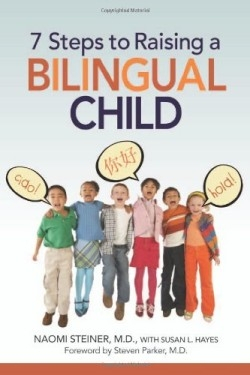Seven Steps to Raising a Bilingual Child
These days, the world seems to be shrinking; information, people, and commodities travel so fast around the globe that China often feels like America’s neighbor. Life in a global village isn’t the only reason to learn more than one language—an increased respect for other cultures and the ability to speak to foreign relatives are other compelling motivations. But promoting bilingualism in children can seem a daunting challenge to parents already overwhelmed with work, school, sports, and all the other elements of modern family life. With her book, 7 Steps to Raising a Bilingual Child, Naomi Steiner, M.D., offers a valuable guide to incorporating the exploration of new languages into daily experience. Steiner, a developmental-behavioral pediatrician whose own children switch comfortably between English, Italian, and German, understands that while the journey to fluency may be difficult, the rewards are immeasurable.
Steiner begins by debunking several myths about bilingualism. For example, she cites the common belief that children become confused when taught more than one language at a young age. She argues that mixing languages in one sentence is a normal part of the learning process and that kids are naturally adept at responding to the circumstance in the most appropriate language they know, an ability often mistaken for confusion by observers. She also reassures those parents who speak only one language that this need not be a roadblock to teaching bilingualism to their children, and indeed in many of her examples the monolingual parent learns a language along with the children.
Other steps include creating a bilingual action plan, preparing for common challenges parents may encounter, and incorporating language learning into formal schooling. Steiner’s suggestions are well researched, concise, and are supported by her extensive experience working with bilingual families. She offers real life examples of people who have opted to pursue bilingual lifestyles at various levels of fluency and describes their successes and challenges with insight and encouragement. Worksheets and tip boxes sprinkled throughout the book reinforce and enhance the highlighted concepts.
Steiner’s passion for languages is obvious on every page and instills inspiration in both parents who’ve always planned to raise their children to be bilingual and in those who never considered bilingualism to be an important possibility. Perhaps, with Steiner’s help, the people of the global village will raise the level of discourse and not only will countries be able to speak to each other, they’ll also be able to understand each other.
Reviewed by
Andi Diehn
Disclosure: This article is not an endorsement, but a review. The publisher of this book provided free copies of the book to have their book reviewed by a professional reviewer. No fee was paid by the publisher for this review. Foreword Reviews only recommends books that we love. Foreword Magazine, Inc. is disclosing this in accordance with the Federal Trade Commission’s 16 CFR, Part 255.

